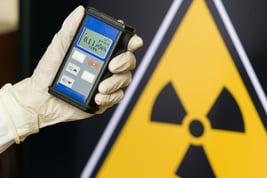
The US federal Occupational Safety and Health Administration (OSHA) regulates workplace exposures to radiation, in two separate standards that distinguish between “non-ionizing” and “ionizing” radiation. OSHA’s Ionizing Radiation Standard (29 CFR 1910.1096) covers workplaces that contain a broad range of high-energy atomic and sub-atomic particles (alpha, beta, gamma, and X-rays, for example), and radioactive materials that emit such particles. The Standard establishes exposure and dosage levels, requires workplace and employee monitoring, and specifies measures to protect workers against ionizing radiation. The rest of this note discusses the Ionizing Radiation Standard. (I wrote about the Non-ionizing Radiation Standard HERE).
Which sources of ionizing radiation does OSHA regulate?
This Standard is modeled on regulations promulgated by the Nuclear Regulatory Commission (NRC), which has broad authority over the production and use of radioactive materials. The Standard generally follows NRC worker safety regulations (see 10 CFR 20), but provides less detailed guidance.
- What are radioactive materials?
This Standard defines radioactive materials as “any material which emits, by spontaneous nuclear disintegration, corpuscular or electromagnetic emanations.” Ionizing radiation covered by this Standard includes alpha rays, beta rays, gamma rays, X-rays, neutrons, high-speed electrons, high-speed protons, and other atomic particles. Ionizing radiation is produced by, among other sources, X-ray equipment, radioactive particle sources, radio-labeled drugs and chemicals, and cathode ray tubes. Ionizing radiation does not include sound or radio waves, visible light, infrared light, or ultraviolet light. (These are covered by the Non-Ionizing Radiation Standard).
- Which radiation sources are subject to regulation?
If a workplace contains any source of ionizing radiation stronger than thresholds specified by NRC and OSHA, it is subject to regulation. OSHA and NRC have undertaken a Memorandum of Understanding, under which OSHA generally defers regulation of sources of ionizing radiation and exposures to these materials to NRC at workplaces subject to NRC regulation. In turn, most states enforce NRC requirements under formal agreements with NRC (“Agreement States”). Because of these deferrals, the employer must determine which agency regulates this activity. In general, NRC/states regulates the following:
-
-
possession and use of “source material, byproduct material, or special nuclear material” as defined by Atomic Energy Act (AEA), in a wide variety of activities
-
contractors operating NRC plants and facilities
-
An employer should know if any of its workplaces holds an NRC/state license.
What does OSHA’s Ionizing Radiation Standard require?
If a workplace has any source that exceeds applicable radiation source levels, and is not regulated by NRC or an Agreement State, the workplace is subject to OSHA requirements. OSHA’s Ionizing Radiation Standard requires some or all of the following:
-
workplace surveys to determine potential exposures
-
identification of any “radiation areas” (more than 5 millirem in any 1 hour, or more than 100 millirem in any 5 consecutive days), “high radiation areas” (radiation could expose a major portion of any worker’s body to more than 100 millirem in any 1 hour), and “airborne radioactivity areas” (referenced to NRC regulatory levels)
-
posting signs and labels on containers and in areas with radioactive materials
-
provision of instruction and information for employees
-
establishment of “restricted areas” that require controls under this Standard
-
provisions to ensure that employee exposures in restricted areas do not exceed specified levels
-
employee monitoring to evaluate actual exposures
-
provisions for evacuation warning signals, if necessary
-
compilation and keeping of exposure records
-
radiation incident reporting to OSHA
-
special handling requirements for radioactive materials and wastes
Limited requirements apply to areas defined as “radiation areas,” and more extensive requirements in “restricted areas.”
What now?
Employers should remain attentive to these requirements, and continue to parse and distinguish OSHA and NRC regulatory requirements.
Self-evaluation checklist
Has the organization conducted surveys to identify workplace ionizing radiation hazards subject to NRC or OSHA regulation?
Has the organization developed and implemented workplace information and safety programs in any workplace area that meets the definition of:
- radiation area
- high radiation area
- airborne radioactivity area
Where Can I Go For More Information?
- OSHA
- Ionizing Radiation Safety and Health webpage
- NRC
- Agreement State Program webpage
About the Author
 Jon Elliott is President of Touchstone Environmental and has been a major contributor to STP’s product range for over 30 years.
Jon Elliott is President of Touchstone Environmental and has been a major contributor to STP’s product range for over 30 years.
Mr. Elliott has a diverse educational background. In addition to his Juris Doctor (University of California, Boalt Hall School of Law, 1981), he holds a Master of Public Policy (Goldman School of Public Policy [GSPP], UC Berkeley, 1980), and a Bachelor of Science in Mechanical Engineering (Princeton University, 1977).
Mr. Elliott is active in professional and community organizations. In addition, he is a past chairman of the Board of Directors of the GSPP Alumni Association, and past member of the Executive Committee of the State Bar of California's Environmental Law Section (including past chair of its Legislative Committee).
You may contact Mr. Elliott directly at: tei@ix.netcom.com

